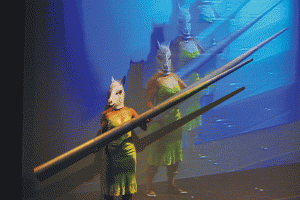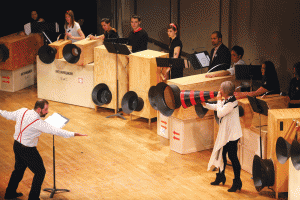« Reviews
PERFORMA 2009

Music for 16 Futurist Noise Intoners. A Performa Commission, 2009. Luciano Chessa on left and Joan La Barbara on right with horn. Photo Paula Court.
By Jeff Edwards
Without Performa 09, the hundredth anniversary of Italian Futurism might have passed fairly quietly on the New York art scene. The coincidence of the movement’s centennial and the massive biennial performance art festival proved beneficial for both. Futurism provided Performa 09 with a perfect theme around which to organize this year’s events, while those events allowed for a more vibrant and captivating commemoration of the oft-maligned Modernist movement than any traditional museum retrospective could possibly have provided.
Many of the items on Performa 09’s calendar only served to ratify the old wisdom on Futurism (i.e., linguistic and typographical experimentation were two of the movement’s strong suits; Futurist experiments in the new technology of cinema were surprisingly gimmicky and regressive; Futurist painting contains some of the most inert portrayals of dynamism ever committed to canvas.).Yet a few events did an impressive job of investigating Futurist byways that were far more radical and creative than many people realize. A concert of vintage and recent compositions performed on a 16-piece orchestra of newly reconstructed crank-operated Futurist intonarumori (noise intoners) sounded as fresh and exciting as anything produced by subsequent eras of experimental music. An Italian Cultural Institute exhibition contrasting works by female Futurist Valentine de Saint-Point with F. T. Marinetti’s more widely-known manifestos showed that at least one woman managed to find a solid-though temporary and grudgingly granted-platform within the male-dominated movement for her radical ideas about the way masculinity and femininity have shaped the grand sweep of world history.
Other Performa 09 events seemed specifically designed to cast light on the abiding effects that these lesser-known Futurist endeavors had on the art world at large. A variety of musical performances honored the powerful influence that Futurist composer (and intonarumori inventor) Luigi Russolo had on the subsequent development of noise music. The most widely anticipated of these was the Mike-Kelley-curated, two-evening concert A Fantastic World Superimposed on Reality, which presented twelve hours of mold-shattering works from composers as diverse as John Cage, Steve Reich, Karlheinz Stockhausen, and Jad Fair. Saint-Point also received her greater due in the form of Lust Weekend, a two-day mini-festival spread across numerous venues that presented dozens of works and performances embodying her assertion that lust is a creative force worthy of the same veneration as any other artistic impulse.
Performa has always been blatantly conscious of the history in which it operates, so it came as no surprise that much of this year’s 22-day run sometimes felt like a crash course in the continuing evolution of performance art. Events like Franklin Furnace’s History of the Future II at Abrons Art Center presented a virtual seminar on the topic, in the form of live actions and film clips spanning the genre’s history. Numerous pioneers of performance art presented works both new and old, including Joan Jonas’ five-night-long Reading Dante at Performance Garage in Soho, and a reprise of Aldo Tambellini and Christoph Draeger’s 1965 multimedia spectacle Black Zero at White Box on the Lower East Side. A series of lectures such as the architect-driven Not For Sale: Ideal Performance Space at Performa Hub considered the future of performance in light of its ever-changing physical and social settings, while a series of new-media-oriented events at Eyebeam argued that this future lies in the populist, dematerialized realm of cyberspace.
Performa’s remarkable growth in just six years should be recognized as a remarkable triumph, albeit with a few reservations. This year’s festival was larger and far more ambitious than its previous two incarnations, with over 100 events presented by more than 150 artists at dozens of venues (including galleries, theaters, public parks, TV stations, and city streets). Due to its sheer size and city-spanning scope, it was able to present something for even the most casual of bystanders. Yet its success also promised annoyance for a core audience of serious performance aficionados. So many events were crammed into the calendar and scheduled against one another that frustration and fatigue seemed inevitable, making one all too aware of being an art consumer, burdened with a scarcity of time in an overcrowded and overheated marketplace. Behemoth that it was, the sanest tactic for any individual to adopt seemed to be to just see what one could and hope for the best.
Abandoning the guilt that comes with not catching every single headline event allowed for the discovery of the many small wonders lurking in the festival’s byways. One could stumble upon miniature (and probably unintentional) subgenres popping up in the oddest combinations, as in the spotlight on female cosmonauts and Soviet-era utopianism found in the works of Spanish artist Alicia Framis and the Polish duo of Christian Tomaszewski and Joanna Malinowska. In Lost Astronaut, Framis adopted the role of a cosmonaut without a space program, cut loose in Manhattan and left to perform three weeks’ worth of pre-scripted daily missions provided by a variety of writers and artists. Tomaszewski and Malinowska’s Mother Earth, Sister Moon turned the raw retail space of the midtown chashama 679 project room into the home of a giant tent-like recreation of cosmonaut Valentina Tereshkova’s space suit, inside which the artists presented a series of evening fashion shows inspired by vintage Eastern-bloc science fiction films. Both wistful and gently cynical, these two parodies of a defunct political behemoth’s outdated visions of tomorrow cast a sly glance toward the absurdity of the Futurists’ attempts to conjure a utopia into existence with little more than bluster and a bit of formalist tinkering.
The best entries in Performa 09 all seemed to reflect a similar combination of sarcasm with a deeper quest to find meaning at the heart of all the theatrics. The most brash and gloriously raucous example of this may have been Camp Kid Friendly by Michael Smith and the hoop dance troop Malcolm Stuart’s Color Wheel. The performance at Sculpture Center in Long Island City presented a live take on Smith and Mike Kelly’s film A Voyage of Growth and Discovery, a savage parody of Burning Man in which Smith’s shambling, diapered man-infant Baby IKKI visits the festival and fits right in with all of the sad boomer infantilism on display. Importing the childish spectacle back into the heart of the art world for one evening pointed the same accusatory finger at the asinine and pretentious silliness that sometimes threatens to sabotage art’s most profound ambitions.
Other examples of combined parody and profundity within Performa 09 were more sober and demure, though no less potent. In 3 Lectures + 1 Story = 4 Evenings at White Columns, Alexandre Singh delivered a series of lecture-performances on art history in which it was sometimes hard to separate the dual roles of brilliant philosopher and smirking wise-ass that he seemed to inhabit in tandem. A display at Participant Inc of videos documenting Stuart Sherman’s cryptic, mini-performance spectacles from the 1970s seemed to vacillate between whimsy and hints of initiatory wisdom, while refusing to either crack a smile or propose solutions to the life’s deeper questions. Singh and Stuart’s works perfectly captured performance art’s occasional ability to mystify, question, or transform reality without taking its own assertions too seriously.
The experimental venture X Initiative hosted a particularly strong run of works in a similar vein, all of which shrewdly exploited art world clichés in order to turn a sharp eye back upon its endless dalliance with pompousness and absurdity in the name of creating magic. Artists and collectives such as Emily Mast, Guillaume Désanges and The Bruce High Quality Foundation University mined a wide range of formats-film, absurdist theatre, lectures, faux panel discussions, and participatory actions, to name a few-presenting clever and often deadpan parodies of each that left it to audience members to figure out where the pretentiousness ended and the insight began. Particularly notable was Désange and Frédéric Cherboeuf’s film Child’s Play, which required nothing more than a few children reenacting famous works of performance art (such as Paul McCarthy’s splattery 1971 video Ma Bell) to show how silly the subject can sometimes look to someone not deeply immersed in its lore.
The willingness of these artists to turn a quizzical and not always sympathetic eye back upon the art world’s posturing made their works some of the most moving and intellectually engaging entries in Performa 09’s entire run. Their potency suggests that Performa’s real value lies beyond its ability to present a sprawling menu of à la carte dishes fit for all tastes. In the wake of performance art’s decades-long history, the presence of such small flashes of self-critical astuteness within the festival’s mammoth bulk may be the thing that keeps it (and the genre as a whole) vital and fresh in the face of new technologies and a post-recession art market. There’s a chance that Performa 09’s reevaluation of Futurism and may be remembered as the festival’s most notable contribution to art history; its ability to nurture such introspective brilliance may be its greatest gift to itself in the future.
(November 1 - 22, 2009)
Jeff Edwards is a freelance writer and a faculty member in the undergraduate Visual and Critical Studies program at the School of Visual Arts (SVA) in New York. A graduate of SVA’s MFA program in Art Criticism and Writing, he also has a Master’s Degree in Public and Private Management from the Yale School of Management.
Filed Under: Reviews



































